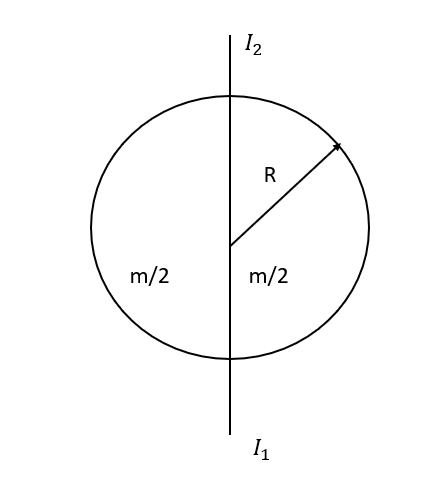
A solid hemisphere and a hemispherical shell are joined as shown. Both of them have $\dfrac{m}{2}$ individually. Find out the moment of inertia about axis $I_{1}$, $I_{2}$.


Answer
503.1k+ views
Hint: We have given the moment of inertia of a solid sphere and a hemispherical shell. Composite system is the combination of the solid sphere and hemispherical shell. The moment of inertia of the is the sum of the moment of inertia of the solid sphere and moment of inertia of the hollow sphere.
Complete step-by-step solution: -
Moment of inertia of the solid sphere, $I_{1} = \dfrac{2}{5} MR^{2}$.
Moment of inertia of the hollow sphere, $I_{2} = \dfrac{2}{3} MR^{2}$.
R is the radius.
The moment of inertia of a rigid composite system is the total moment of inertia of its component subsystems.
Moment of inertia,
$I = \dfrac{2}{3} MR^{2} + \dfrac{2}{5} MR^{2}$
$\implies I = \dfrac{16}{15} MR^{2}$
Given: $M = \dfrac{m}{2}$
$ I = \dfrac{16}{15} \times \dfrac{m}{2} \times R^{2}$
$\implies I = \dfrac{8}{15} MR^{2}$
Note: The moment of inertia is a quantity that defines the torque required for a desired angular acceleration around a rotational axis, how mass defines the force needed for the wanted acceleration. It depends on the body's mass configuration and the axis taken, with significant moments needing more torque to alter its rotation rate. It is an extensive property: the moment of inertia is just the mass times the perpendicular distance square to the pole of rotation. The moment of inertia of a complex composite system is the actual inertia of its component subsystems.
Complete step-by-step solution: -
Moment of inertia of the solid sphere, $I_{1} = \dfrac{2}{5} MR^{2}$.
Moment of inertia of the hollow sphere, $I_{2} = \dfrac{2}{3} MR^{2}$.
R is the radius.
The moment of inertia of a rigid composite system is the total moment of inertia of its component subsystems.
Moment of inertia,
$I = \dfrac{2}{3} MR^{2} + \dfrac{2}{5} MR^{2}$
$\implies I = \dfrac{16}{15} MR^{2}$
Given: $M = \dfrac{m}{2}$
$ I = \dfrac{16}{15} \times \dfrac{m}{2} \times R^{2}$
$\implies I = \dfrac{8}{15} MR^{2}$
Note: The moment of inertia is a quantity that defines the torque required for a desired angular acceleration around a rotational axis, how mass defines the force needed for the wanted acceleration. It depends on the body's mass configuration and the axis taken, with significant moments needing more torque to alter its rotation rate. It is an extensive property: the moment of inertia is just the mass times the perpendicular distance square to the pole of rotation. The moment of inertia of a complex composite system is the actual inertia of its component subsystems.
Recently Updated Pages
Why are manures considered better than fertilizers class 11 biology CBSE

Find the coordinates of the midpoint of the line segment class 11 maths CBSE

Distinguish between static friction limiting friction class 11 physics CBSE

The Chairman of the constituent Assembly was A Jawaharlal class 11 social science CBSE

The first National Commission on Labour NCL submitted class 11 social science CBSE

Number of all subshell of n + l 7 is A 4 B 5 C 6 D class 11 chemistry CBSE

Trending doubts
What is meant by exothermic and endothermic reactions class 11 chemistry CBSE

10 examples of friction in our daily life

One Metric ton is equal to kg A 10000 B 1000 C 100 class 11 physics CBSE

1 Quintal is equal to a 110 kg b 10 kg c 100kg d 1000 class 11 physics CBSE

Difference Between Prokaryotic Cells and Eukaryotic Cells

What are Quantum numbers Explain the quantum number class 11 chemistry CBSE




